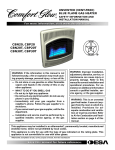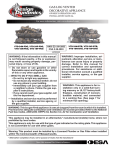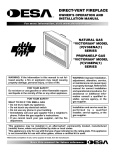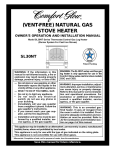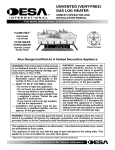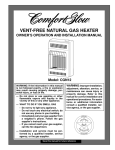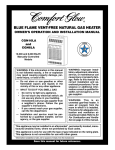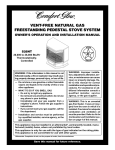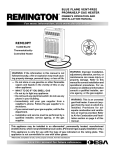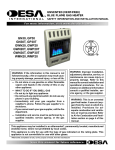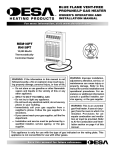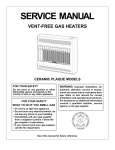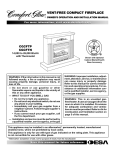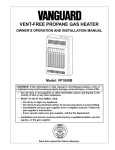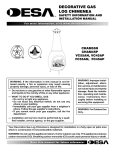Download Owners Manual - Desa Parts and Desa Tech Support Manuals
Transcript
UNVENTED (VENT-FREE) BLUE FLAME GAS HEATER SAFETY INFORMATION AND INSTALLATION MANUAL For more information, visit www.desatech.com CBN20, CBP20 SBN20, SBP20 CBN20T, CBP20T CBN30T, CBP30T CBT20NT, CBT20PT CBT30NT, CBT30PT CBN20TK, CBP20TK WARNING: If the information in this manual is not followed exactly, a fire or explosion may result causing property damage, personal injury, or loss of life. — Do not store or use gasoline or other flammable vapors and liquids in the vicinity of this or any other appliance. — WHAT TO DO IF YOU SMELL GAS • Do not try to light any appliance. • Do not touch any electrical switch; do not use any phone in your building. • Immediately call your gas supplier from a neighbor’s phone. Follow the gas supplier’s instructions. • If you cannot reach your gas supplier, call the fire department. — Installation and service must be performed by a qualified installer, service agency, or the gas supplier. WARNING: Improper installation, adjustment, alteration, service, or maintenance can cause injury or property damage. Refer to this manual for correct installation and operational procedures. For assistance or additional information consult a qualified installer, service agency, or the gas supplier. WARNING: This is an unvented gas-fired heater. It uses air (oxygen) from the room in which it is installed. Provisions for adequate combustion and ventilation air must be provided. Refer to Air for Combustion and Ventilation section on page 4 of this manual. This appliance may be installed in an aftermarket*, permanently located, manufactured (mobile) home, where not prohibited by local codes. This appliance is only for use with the type of gas indicated on the rating plate. This appliance is not convertible for use with other gases. *Aftermarket: Completion of sale, not for purpose of resale, from the manufacturer Save this manual for future reference. 2 TABLE OF CONTENTS SAFETY INFORMATION TABLE OF CONTENTS SAFETY INFORMATION ............................................................ 2 SERVICE HINTS ....................................................................... 16 LOCAL CODES ........................................................................... 3 TECHNICAL SERVICE ............................................................. 16 PRODUCT IDENTIFICATION ..................................................... 3 SERVICE PUBLICATIONS ....................................................... 16 UNPACKING ............................................................................... 3 TROUBLESHOOTING .............................................................. 17 PRODUCT FEATURES .............................................................. 3 ILLUSTRATED PARTS BREAKDOWN AND PARTS LIST ....... 20 AIR FOR COMBUSTION AND VENTILATION ........................... 4 REPLACEMENT PARTS .......................................................... 26 INSTALLATION ........................................................................... 7 ACCESSORIES ........................................................................ 26 OPERATING HEATER .............................................................. 13 OWNER’S REGISTRATION FORM .......................................... 27 INSPECTING HEATER ............................................................. 14 PARTS CENTRALS .................................................................. 29 CLEANING AND MAINTENANCE ............................................ 15 WARRANTY INFORMATION ...................................... Back Cover SPECIFICATIONS .................................................................... 16 SAFETY INFORMATION WARNING ICON G 001 WARNINGS Due to high temperatures, the appliance should be located out of traffic and away from furniture and draperies. IMPORTANT: Read this owner’s manual carefully and completely before trying to assemble, operate, or service this heater. Improper use of this heater can cause serious injury or death from burns, fire, explosion, electrical shock, and carbon monoxide poisoning. Do not place clothing or other flammable material on or near the appliance. Never place any objects on the heater. DANGER: Carbon monoxide poisoning may lead to death! Surface of heater becomes very hot when running heater. Keep children and adults away from hot surface to avoid burns or clothing ignition. Heater will remain hot for a time after shutdown. Allow surface to cool before touching. Carbon Monoxide Poisoning: Early signs of carbon monoxide poisoning resemble the flu, with headaches, dizziness, or nausea. If you have these signs, the heater may not be working properly. Get fresh air at once! Have heater serviced. Some people are more affected by carbon monoxide than others. These include pregnant women, people with heart or lung disease or anemia, those under the influence of alcohol, and those at high altitudes. Carefully supervise young children when they are in the same room with heater. Natural and Propane/LP Gas: Natural and propane/LP gases are fuel gases. Fuel gases are odorless. An odor-making agent are added to fuel gases. The odor helps you detect a fuel gas leak. However, the odor added to fuel gas can fade. Fuel gas may be present even though no odor exists. Make sure grill guard is in place before running heater. Keep the appliance area clear and free from combustible materials, gasoline and other flammable vapors and liquids. Make certain you read and understand all warnings. Keep this manual for reference. It is your guide to safe and proper operation of this heater. 1. WARNING: Any change to this heater or its controls can be dangerous. 2. WARNING: Do not use any accessory not approved for use with this heater. This appliance is only for use with the type of gas indicated on the rating plate. This appliance is not convertible for use with other gases. Do not place propane/LP supply tank(s) inside any structure. Locate propane/LP supply tank(s) outdoors (propane/LP models only). For more information, visit www.desatech.com 107882-01H SAFETY INFORMATION LOCAL CODES PRODUCT IDENTIFICATION UNPACKING PRODUCT FEATURES SAFETY INFORMATION 3. 4. 5. 6. 7. 8. 9. 10. 11. 12. 13. If you smell gas • shut off gas supply • do not try to light any appliance • do not touch any electrical switch; do not use any phone in your building • immediately call your gas supplier from a neighbor’s phone. Follow the gas supplier’s instructions • if you cannot reach your gas supplier, call the fire department This heater shall not be installed in a bedroom or bathroom. This heater needs fresh, outside air ventilation to run properly. This heater has an Oxygen Depletion Sensing (ODS) safety shutoff system. The ODS shuts down the heater if not enough fresh air is available. See Air for Combustion and Ventilation, pages 4 through 6. Keep all air openings in front and bottom of heater clear and free of debris. This will insure enough air for proper combustion. If heater shuts off, do not relight until you provide fresh, outside air. If heater keeps shutting off, have it serviced. Do not run heater • where flammable liquids or vapors are used or stored • under dusty conditions Do not use heater if any part has been under water. Immediately call a qualified service technician to inspect the room heater and to replace any part of the control system and any gas control which has been under water. Turn off and let cool before servicing. Only a qualified service person should service and repair heater. Operating heater above elevations of 4,500 feet could cause pilot outage. To prevent performance problems, do not use propane/LP fuel tank of less than 100 lbs. capacity (propane/LP models only). Provide adequate clearances around air openings. 3 3 PRODUCT IDENTIFICATION Heater Cabinet Control Knob & Ignitor Button (not seen from this view) Grill Guard Glass Panel Front Panel Figure 1 - Vent-Free Gas Heater UNPACKING 1. 2. 3. Remove heater from carton. Remove all protective packaging applied to heater for shipment. Check heater for any shipping damage. If heater is damaged, promptly return to dealer where you bought heater. PRODUCT FEATURES LOCAL CODES SAFETY DEVICE Install and use heater with care. Follow all local codes. In the absence of local codes, use the latest edition of National Fuel Gas Code, ANSI Z223.1/NFPA 54*. This heater has a pilot with an Oxygen Depletion Sensing (ODS) safety shutoff system. The ODS/pilot is a required feature for ventfree room heaters. The ODS/pilot shuts off the heater if there is not enough fresh air. *Available from: American National Standards Institute, Inc. 1430 Broadway New York, NY 10018 National Fire Protection Association, Inc. Batterymarch Park Quincy, MA 02269 IGNITION SYSTEM This heater has either a piezo ignitor or electronic ignitor to light heater fuel supply. THERMOSTATIC HEAT CONTROL Thermostat models have a thermostat sensing bulb and a control valve. This results in the greatest heater comfort. This can also result in lower gas bills. For more information, visit www.desatech.com 107882-01H 4 AIR FOR COMBUSTION AND VENTILATION Providing Adequate Ventilation AIR FOR COMBUSTION AND VENTILATION Today’s homes are built more energy efficient than ever. New materials, increased insulation, and new construction methods help reduce heat loss in homes. Home owners weather strip and caulk around windows and doors to keep the cold air out and the warm air in. During heating months, home owners want their homes as airtight as possible. Unusually tight construction is defined as construction where: a. walls and ceilings exposed to the outside atmosphere have a continuous water vapor retarder with a rating of one perm (6x10-11 kg per pa-sec-m2) or less with openings gasketed or sealed and b. weather stripping has been added on openable windows and doors and c. caulking or sealants are applied to areas such as joints around window and door frames, between sole plates and floors, between wall-ceiling joints, between wall panels, at penetrations for plumbing, electrical, and gas lines, and at other openings. While it is good to make your home energy efficient, your home needs to breathe. Fresh air must enter your home. All fuel-burning appliances need fresh air for proper combustion and ventilation. If your home meets all of the three criteria above, you must provide additional fresh air. See Ventilation Air From Outdoors, page 6. Exhaust fans, fireplaces, clothes dryers, and fuel burning appliances draw air from the house to operate. You must provide adequate fresh air for these appliances. This will insure proper venting of vented fuel-burning appliances. If your home does not meet all of the three criteria above, proceed to Determining Fresh-Air Flow For Heater Location, page 5. PROVIDING ADEQUATE VENTILATION The National Fuel Gas Code, ANSI Z223.1/NFPA 54 defines a confined space as a space whose volume is less than 50 cubic feet per 1,000 Btu per hour (4.8 m3 per kw) of the aggregate input rating of all appliances installed in that space and an unconfined space as a space whose volume is not less than 50 cubic feet per 1,000 Btu per hour (4.8 m3 per kw) of the aggregate input rating of all appliances installed in that space. Rooms communicating directly with the space in which the appliances are installed*, through openings not furnished with doors, are considered a part of the unconfined space. WARNING: This heater shall not be installed in a confined space or unusually tight construction unless provisions are provided for adequate combustion and ventilation air. Read the following instructions to insure proper fresh air for this and other fuel-burning appliances in your home. The following are excerpts from National Fuel Gas Code, ANSI Z223.1/NFPA 54, Section 5.3, Air for Combustion and Ventilation. All spaces in homes fall into one of the three following ventilation classifications: 1. Unusually Tight Construction 2. Unconfined Space 3. Confined Space The information on pages 4 through 6 will help you classify your space and provide adequate ventilation. Confined and Unconfined Space * Adjoining rooms are communicating only if there are doorless passageways or ventilation grills between them. Unusually Tight Construction The air that leaks around doors and windows may provide enough fresh air for combustion and ventilation. However, in buildings of unusually tight construction, you must provide additional fresh air. For more information, visit www.desatech.com 107882-01H AIR FOR COMBUSTION AND VENTILATION Determining Fresh-Air Flow For Heater Location 5 5 AIR FOR COMBUSTION AND VENTILATION Continued DETERMINING FRESH-AIR FLOW FOR HEATER LOCATION 4. Compare the maximum Btu/Hr the space can support with the actual amount of Btu/Hr used. __________________ Btu/Hr (maximum the space can support) Determining if You Have a Confined or Unconfined Space __________________ Btu/Hr (actual amount of Btu/Hr used) Example: 51,200 Btu/Hr (maximum the space can support) Use this work sheet to determine if you have a confined or unconfined space. Space: Includes the room in which you will install heater plus any adjoining rooms with doorless passageways or ventilation grills between the rooms. 1. 60,000 Btu/Hr (actual amount of Btu/Hr used) Determine the volume of the space (length x width x height). The space in the above example is a confined space because the actual Btu/Hr used is more than the maximum Btu/Hr the space can support. You must provide additional fresh air. Your options are as follows: Length x Width x Height = ___________ cu. ft. (volume of space) A. If additional ventilation to adjoining room is supplied with grills or openings, add the volume of these rooms to the total volume of the space. Rework worksheet, adding the space of an adjoining room. If the extra space provides an unconfined space, remove door to adjoining room or add ventilation grills between rooms. See Ventilation Air From Inside Building, page 6. B. Multiply the space volume by 20 to determine the maximum Btu/Hr the space can support. Vent room directly to the outdoors. See Ventilation Air From Outdoors, page 6. C. Install a lower Btu/Hr heater, if lower Btu/Hr size makes room unconfined. Example: Space size 20 ft. (length) x 16 ft. (width) x 8 ft. (ceiling height) = 2560 cu. ft. (volume of space) 2. __________ (volume of space) x 20 = (Maximum Btu/Hr the space can support) Example: 2560 cu. ft. (volume of space) x 20 = 51,200 (maximum Btu/Hr the space can support) 3. Add the Btu/Hr of all fuel burning appliances in the space. Vent-free heater _____________ Btu/Hr Gas water heater* _____________ Btu/Hr Gas furnace _____________ Btu/Hr Vented gas heater _____________ Btu/Hr Gas fireplace logs _____________ Btu/Hr Other gas appliances* + _____________ Btu/Hr Total = _____________ Btu/Hr If the actual Btu/Hr used is less than the maximum Btu/Hr the space can support, the space is an unconfined space. You will need no additional fresh air ventilation. WARNING: If the area in which the heater may be operated is smaller than that defined as an unconfined space or if the building is of unusually tight construction, provide adequate combustion and ventilation air by one of the methods described in the National Fuel Gas Code, ANSI Z223.1/NFPA 54 Section 5.3 or applicable local codes. * Do not include direct-vent gas appliances. Direct-vent draws combustion air from the outdoors and vents to the outdoors. Example: 40,000 Gas water heater _____________ Btu/Hr 20,000 Vent-free heater + _____________ Btu/Hr 60,000 Total = _____________ Btu/Hr For more information, visit www.desatech.com 107882-01H 6 AIR FOR COMBUSTION AND VENTILATION Ventilation Air AIR FOR COMBUSTION AND VENTILATION Continued VENTILATION AIR 12" Ventilation Air From Inside Building This fresh air would come from an adjoining unconfined space. When ventilating to an adjoining unconfined space, you must provide two permanent openings: one within 12" of the ceiling and one within 12" of the floor on the wall connecting the two spaces (see options 1 and 2, Figure 2). You can also remove door into adjoining room (see option 3, Figure 2). Follow the National Fuel Gas Code, ANSI Z223.1/NFPA 54, Section 5.3, Air for Combustion and Ventilation for required size of ventilation grills or ducts. Ventilation Grills into Adjoining Room, Option 1 Ventilation Grills Into Adjoining Room, Option 2 Or Remove Door into Adjoining Room, Option 3 Ventilation Air From Outdoors Provide extra fresh air by using ventilation grills or ducts. You must provide two permanent openings: one within 12" of the ceiling and one within 12" of the floor. Connect these items directly to the outdoors or spaces open to the outdoors. These spaces include attics and crawl spaces. Follow the National Fuel Gas Code, ANSI Z223.1/NFPA 54, Section 5.3, Air for Combustion and Ventilation for required size of ventilation grills or ducts. IMPORTANT: Do not provide openings for inlet or outlet air into attic if attic has a thermostat-controlled power vent. Heated air entering the attic will activate the power vent. 12" Figure 2 - Ventilation Air from Inside Building Outlet Air Ventilated Attic Outlet Air To Attic To Crawl Space Inlet Air Inlet Air Ventilated Crawl Space Figure 3 - Ventilation Air from Outdoors For more information, visit www.desatech.com 107882-01H INSTALLATION Check Gas Type Installation Items Locating Heater 7 7 INSTALLATION NOTICE: This heater is intended for use as supplemental heat. Use this heater along with your primary heating system. Do not install this heater as your primary heat source. If you have a central heating system, you may run system’s circulating blower while using heater. This will help circulate the heat throughout the house. In the event of a power outage, you can use this heater as your primary heat source. WARNING: A qualified service person must install heater. Follow all local codes. CHECK GAS TYPE Use only the correct type of gas (natural or propane/LP). If your gas supply is not the correct gas type, do not install heater. Call dealer where you bought heater for proper type heater. WARNING: Never install the heater • in a bedroom or bathroom • in a recreational vehicle • where curtains, furniture, clothing, or other flammable objects are less than 36 inches from the front, top, or sides of the heater • as a fireplace insert • in high traffic areas • in windy or drafty areas CAUTION: This heater creates warm air currents. These currents move heat to wall surfaces next to heater. Installing heater next to vinyl or cloth wall coverings or operating heater where impurities (such as, but not limited to, tobacco smoke, aromatic candles, cleaning fluids, oil or kerosene lamps, etc.) in the air exist, may discolor walls or cause odors. INSTALLATION ITEMS Before installing heater, make sure you have the items listed below. • for propane/LP gas, external regulator (supplied by installer) • piping (check local codes) • sealant (resistant to propane/LP gas) • equipment shutoff valve * • ground joint union • sediment trap • tee joint • pipe wrench • test gauge connection* * A CSA design-certified equipment shutoff valve with 1/8" NPT tap is an acceptable alternative to test gauge connection. The optional CSA design-certified equipment shutoff valve can be purchased from your dealer. See Accessories, page 26. LOCATING HEATER WARNING: Maintain the minimum clearances shown in Figure 4. If you can, provide greater clearances from floor, ceiling, and joining wall. You can locate heater on the floor, away from a wall. A wall mounting bracket is included with this heater. An Optional Base Kit (GA4550) may be purchased to allow the unit to be installed away from a wall (see Accessories, page 26). Determine which method is best for your application. CEILING 36" Minimum 6" Minimum From Sides Of Heater Left Side Right Side FLOOR 2" Minimum To Top Surface Of Carpeting, Tile Or Other Combustible Material Figure 4 - Mounting Clearances As Viewed From Front of Heater IMPORTANT: Vent-free heaters add moisture to the air. Although this is beneficial, installing heater in rooms without enough ventilation air may cause mildew to form from too much moisture. See Air for Combustion and Ventilation, pages 4 through 6. If high humidity is experienced, a dehumidifier may be used to help lower the water vapor content in the air. CAUTION: If you install the heater in a home garage • heater pilot and burner must be at least 18 inches above floor • locate heater where moving vehicle will not hit it For convenience and efficiency, install heater • where there is easy access for operation, inspection, and service • in coldest part of room An optional fan kit is available from your dealer. See Accessories, page 26. If planning to use fan, locate heater near an electrical outlet. For more information, visit www.desatech.com 107882-01H 8 INSTALLATION Thermostat Sensing Bulb Installing Heater To Wall INSTALLATION Continued THERMOSTAT SENSING BULB Removing Front Panel Of Heater The thermostat sensing bulb has been placed inside the heater for protection during shipping. 1. 2. 3. Locating Thermostat Sensing Bulb (for thermostat applications) 1. 2. Remove the four painted screws, two on each side of front panel. Pull bottom of front panel forward, then out. Remove any remaining packaging materials. Remove front panel of heater (see Figure 7). Locate thermostat sensing bulb just under burner assembly. IMPORTANT: Attach thermostat sensing bulb to back of heater for proper operation. Attaching Thermostat Sensing Bulb 1. 2. 3. Remove thermostat sensing bulb from holders inside heater. Route through slot opening in bottom of heater. Place clamp on thermostat sensing bulb as shown in Figure 5. Clamp is provided in hardware package. Snap clamp into upper mounting hole as shown in Figure 5. Mounting hole is located on lower left edge on back of heater. Make sure the thermostat sensing bulb is pointing up. Figure 7 - Removing Front Panel Of Heater Thermostat Sensing Bulb Methods For Attaching Mounting Bracket To Wall Clamp Only use last hole on each end of mounting bracket to attach bracket to wall. These two holes are 14 inches apart from their centers. Attach mounting bracket to wall in one of two ways: 1. Attaching to wall stud 2. Attaching to wall anchor Attaching to Wall Stud: This method provides the strongest hold. Insert mounting screws through mounting bracket and into wall studs. Figure 5 - Attaching Thermostat Sensing Bulb Attaching to Wall Anchor: This method allows you to attach INSTALLING HEATER TO WALL mounting bracket to hollow walls (wall areas between studs) or to solid walls (concrete or masonry). Mounting Bracket Decide which method better suits your needs. Either method will provide a secure hold for the mounting bracket. Locate mounting bracket in heater carton. Remove mounting bracket from heater carton. Marking Screw Locations 1. Figure 6 - Mounting Bracket Tape mounting bracket to wall where heater will be located. Make sure mounting bracket is level. WARNING: Maintain minimum clearances shown in Figure 8, page 9. If you can, provide greater clearances from floor and joining wall. For more information, visit www.desatech.com 107882-01H INSTALLATION Installing Heater To Wall (Cont.) 9 9 INSTALLATION Continued 2. 3. Mark screw locations on wall (see Figure 8). Note: Only mark last hole on each end of mounting bracket. Insert mounting screws through these holes only. Remove tape and mounting bracket from wall. Adjoining Wall 12" Min. 14" Only Insert Mounting Screws Through Last Hole On Each End 18 3/4" Min. Floor 30,000 Btu/hr Models 8" Min. 14" Attaching To Wall Anchor Method For attaching mounting bracket to hollow walls (wall areas between studs) or solid walls (concrete or masonry) 1. Drill holes at marked locations using 5/16" drill bit. For solid walls (concrete or masonry), drill at least 1" deep. 2. Fold wall anchor as shown in Figure 9. 3. Insert wall anchor (wings first) into hole. Tap anchor flush to wall. 4. For thin walls (1/2" or less), insert red key into wall anchor. Push red key to “pop” open anchor wings. IMPORTANT: Do not hammer key! For thick walls (over 1/2" thick) or solid walls, do not pop open wings. 5. Place mounting bracket onto wall. Line up last hole on each end of bracket with wall anchors. 6. Insert mounting screws through bracket and into wall anchors. 7. Tighten screws until mounting bracket is firmly fastened to wall. Adjoining Wall Placing Heater On Mounting Bracket Only Insert Mounting Screws Through Last Hole On Each End 18 3/4" Min. 1. 2. Locate two horizontal slots on back panel of heater. Place heater onto mounting bracket. Slide horizontal slots onto stand-out tabs on mounting bracket. Floor 20,000 Btu/hr Models Figure 8 - Mounting Bracket Clearances Figure 9 - Folding Anchor Attaching Mounting Bracket To Wall Figure 10 - Popping Open Anchor Wings For Thin Walls Horizontal Slots Note: Wall anchors, mounting screws, and spacers are in hardware package. The hardware package is provided with heater. Attaching To Wall Stud Method For attaching mounting bracket to wall studs 1. Drill holes at marked locations using 9/64" drill bit. 2. Place mounting bracket onto wall. Line up last hole on each end of bracket with holes drilled in wall. 3. Insert mounting screws through bracket and into wall studs. 4. Tighten screws until mounting bracket is firmly fastened to wall studs. Stand-Out Tab Figure 11 - Mounting Heater Onto Mounting Bracket For more information, visit www.desatech.com 107882-01H Mounting Bracket (attached to wall) 10 INSTALLATION Installing Heater To Wall (Cont.) Mounting Heater To Floor INSTALLATION Continued MOUNTING HEATER TO FLOOR (OPTIONAL) Installing Bottom Mounting Screws 1. 2. 3. 4. 5. 6. 7. 8. Locate two bottom mounting holes. These holes are near bottom on back panel of heater (see Figure 12). Mark screw locations on wall. Remove heater from mounting bracket. If installing bottom mounting screws into hollow or solid wall, install wall anchors. Follow steps 1 through 4 under Attaching To Wall Anchor Method, page 9. If installing bottom mounting screw into wall stud, drill holes at marked locations using 9/64" drill bit. Replace heater onto mounting bracket. Place spacers between bottom mounting holes and wall anchor or drilled hole. Hold spacer in place with one hand. With other hand, insert mounting screw through bottom mounting hole and spacer. Place tip of screw in opening of wall anchor or drilled hole. Tighten both screws until heater is firmly secured to wall. Do not over tighten. Note: Do not replace front panel at this time. Replace front panel after making gas connections and checking for leaks (see pages 11 and 12). Mounting Base Feet to Heater 1. 2. 3. 4. Lay heater cabinet on its back on a table with the heater bottom overhanging the table edge. Align holes in base foot with mounting holes on bottom of cabinet (see Figure 13). Secure base foot to heater using sheet metal screws. Repeat for other side. Mounting Base Feet to Floor (Where required by local code) 1. 2. 3. 4. Remove front cover (see Removing Front Panel of Heater, page 8). Position heater with base feet in desired location. Mark holes for drilling. Remove heater with base. For carpeted floors, make a small cut with a sharp knife at marked locations prior to drilling. If mounting base to a wood floor, drill 1/8 inch diameter hole, 3/4 inch deep. (Do not use anchors in wood floors). If mounting base to a concrete floor, drill with 1/4 inch diameter concrete drill bit, 13/8 inches into floor. Insert anchors completely into holes. Reposition heater with base feet over holes. Secure base to floor with wood screws. See Figure 13. Wood Screw Front View Heater Wall Spacer Side View Base Foot Sheet Metal Screw Figure 12 - Installing Bottom Mounting Screws Figure 13 - Installing Base Feet For more information, visit www.desatech.com 107882-01H INSTALLATION Connecting To Gas Supply 11 11 INSTALLATION Continued Typical Inlet Pipe Diameters CONNECTING TO GAS SUPPLY 20,000 Btu/Hr Models - 3/8" or greater WARNING: This appliance requires a 3/8" NPT (National Pipe Thread) inlet connection to the pressure regulator. WARNING: A qualified service person must connect heater to gas supply. Follow all local codes. 30,000 Btu/Hr Models - 1/2" or greater Installation must include equipment shutoff valve, union, and plugged 1/8" NPT tap. Locate NPT tap within reach for test gauge hook up. NPT tap must be upstream from heater (see Figure 15). IMPORTANT: Install an equipment shutoff valve in an accessible location. The equipment shutoff valve is for turning on or shutting off the gas to the appliance. WARNING: For natural gas, never connect heater to private (non-utility) gas wells. This gas is commonly known as wellhead gas. Apply pipe joint sealant lightly to male NPT threads. This will prevent excess sealant from going into pipe. Excess sealant in pipe could result in clogged heater valves. IMPORTANT: For natural gas, check gas line pressure before connecting heater to gas line. Gas line pressure must be no greater than 10.5 inches of water. If gas line pressure is higher, heater regulator damage could occur. WARNING: Use pipe joint sealant that is resistant to liquid petroleum (LP) gas. CAUTION: For propane/LP gas, never connect heater directly to the propane/LP supply. This heater requires an external regulator (not supplied). Install the external regulator between the heater and propane/LP supply. For propane/LP gas, the installer must supply an external regulator. The external regulator will reduce incoming gas pressure. You must reduce incoming gas pressure to between 11 and 14 inches of water. If you do not reduce incoming gas pressure, heater regulator damage could occur. Install the external regulator with the vent pointing down as shown in Figure 14. Pointing the vent down protects it from freezing rain or sleet. Propane/LP Supply Tank Install sediment trap in supply line as shown in Figure 15. Locate sediment trap where it is within reach for cleaning. Locate sediment trap where trapped matter is not likely to freeze. A sediment trap traps moisture and contaminants. This keeps them from going into heater controls. If sediment trap is not installed or is installed wrong, heater may not run properly. IMPORTANT: Hold the pressure regulator with wrench when connecting it to gas piping and/or fittings. Do not over tighten pipe connection to regulator. The regulator body could be damaged. Pressure Regulator 3/8" NPT Pipe Nipple External Regulator Tee Joint Vent Pointing Down Figure 14 - External Regulator With Vent Pointing Down CAUTION: Use only new, black iron or steel pipe. Internally-tinned copper tubing may be used in certain areas. Check your local codes. Use pipe of large enough diameter to allow proper gas volume to heater. If pipe is too small, undue loss of volume will occur. Test Gauge Connection* Reducer Bushing to 1/8" NPT 1/8" NPT Plug Tap Tee Joint Sediment Trap Pipe Nipple Cap Figure 15 - Gas Connection Heater Cabinet Ground Joint Union Equipment Shutoff Valve * Natural Gas From Gas Meter (5" W.C. to 10.5" W.C. Pressure) 3" Propane/LP Minimum From External Regulator (11" W.C. to 14" W.C. Pressure) * A CSA design-certified equipment shutoff valve with 1/8" NPT tap is an acceptable alternative to test gauge connection. Purchase the optional CSA design-certified equipment shutoff valve from your dealer. See Accessories, page 26. For more information, visit www.desatech.com 107882-01H Note: Burner bracket not shown for clarity 12 INSTALLATION Checking Gas Connections INSTALLATION Continued CHECKING GAS CONNECTIONS WARNING: Test all gas piping and connections, internal and external to unit, for leaks after installing or servicing. Correct all leaks at once. WARNING: Never use an open flame to check for a leak. Apply a noncorrosive leak detection fluid to all joints. Bubbles forming show a leak. Correct all leaks at once. CAUTION: For propane/LP gas, make sure external regulator has been installed between propane/LP supply and heater. See guidelines under Connecting to Gas Supply, page 11. Pressure Testing Gas Supply Piping System Pressure Testing Heater Gas Connections 1. 2. 3. 4. 5. 6. 7. 8. Open equipment shutoff valve (see Figure 16). For natural gas open main gas valve located on or near gas meter. For propane/LP gas open propane/LP supply tank valve. Make sure control knob of heater is in the OFF position. Check all joints from equipment shutoff valve to thermostat gas valve (see Figure 17 or 18). Apply a noncorrosive leak detection fluid to all joints. Bubbles forming show a leak. Correct all leaks at once. Light heater (see Operating Heater, page 13). Check all other internal joints for leaks. Turn off heater (see To Turn Off Gas to Appliance, page 14). Replace front panel. Open ON POSIT Equipment Shutoff Valve Test Pressures In Excess Of 1/2 PSIG (3.5 kPa) 1. 2. 3. 4. 5. 6. Disconnect appliance with its appliance main gas valve (control valve) and equipment shutoff valve from gas supply piping system. Pressures in excess of 1/2 psig will damage heater regulator. Cap off open end of gas pipe where equipment shutoff valve was connected. Pressurize supply piping system by either opening propane/LP supply tank valve for propane/LP gas or opening main gas valve located on or near gas meter for natural gas, or using compressed air. Check all joints of gas supply piping system. Apply a noncorrosive leak detection fluid to all joints. Bubbles forming show a leak. Correct all leaks at once. Reconnect heater and equipment shutoff valve to gas supply. Check reconnected fittings for leaks. O POS Closed Figure 16 - Equipment Shutoff Valve Thermostat Gas Valve Gas Meter Equipment Shutoff Valve Figure 17 - Checking Gas Joints for Natural Gas Test Pressures Equal To or Less Than 1/2 PSIG (3.5 kPa) 1. 2. 3. 4. Close equipment shutoff valve (see Figure 16). Pressurize supply piping system by either opening propane/LP supply tank valve for propane/LP gas or opening main gas valve located on or near gas meter for natural gas, or using compressed air. Check all joints from gas meter for natural gas (see Figure 17) or propane/LP supply tank for propane/LP gas, to equipment shutoff valve (see Figure 18). Apply a noncorrosive leak detection fluid to all joints. Bubbles forming show a leak. Correct all leaks at once. Propane/LP Supply Tank Thermostat Gas Valve Equipment Shutoff Valve Figure 18 - Checking Gas Joints for Propane/LP Gas For more information, visit www.desatech.com 107882-01H OPERATING HEATER For Your Safety Read Before Lighting Lighting Instructions 13 13 OPERATING HEATER FOR YOUR SAFETY READ BEFORE LIGHTING A. This appliance has a pilot which must be lighted by hand. When lighting the pilot, follow these instructions exactly. B. BEFORE LIGHTING smell all around the appliance area for gas. Be sure to smell next to the floor because some gas is heavier than air and will settle on the floor. WHAT TO DO IF YOU SMELL GAS • Do not try to light any appliance. • Do not touch any electric switch; do not use any phone in your building. • Immediately call your gas supplier from a neighbor’s phone. Follow the gas supplier’s instructions. • If you cannot reach your gas supplier, call the fire department. C. Use only your hand to push in or turn the gas control knob. Never use tools. If the knob will not push in or turn by hand, don’t try to repair it, call a qualified service technician or gas supplier. Force or attempted repair may result in a fire or explosion. D. Do not use this appliance if any part has been under water. Immediately call a qualified service technician to inspect the appliance and to replace any part of the control system and any gas control which has been under water. LIGHTING INSTRUCTIONS 6. 7. 8. CAUTION: Do not try to adjust heating levels by using the equipment shutoff valve. Ignitor Button Control Knob LO WARNING: If you do not follow these instructions exactly, a fire or explosion may result causing property damage, personal injury or loss of life. Note: You may be running this heater for the first time after hooking up to gas supply. If so, the control knob may need to be pressed in for 30 seconds or more. This will allow air to bleed from the gas system. • If control knob does not pop up when released, contact a qualified service person or gas supplier for repairs. With control knob pressed in, push down and release ignitor button (see Figure 19). This will light pilot. The pilot is attached to the front of burner. The pilot can be seen through the glass panel. If needed, keep pressing ignitor button until pilot lights. Note: If pilot does not stay lit, refer to Troubleshooting, pages 17 through 19. Also contact a qualified service person or gas supplier for repairs. Until repairs are made, light pilot with match. To light pilot with match, see Manual Lighting Procedure, page 14. Keep control knob pressed in for 30 seconds after lighting pilot. After 30 seconds, release control knob. • If control knob does not pop up when released, contact a qualified service person or gas supplier for repairs. Note: If pilot goes out, repeat steps 3 through 7. This heater has a safety interlock system. Wait one (1) minute before lighting pilot again. Turn control knob counterclockwise to desired heating level. The main burner should light. Set control knob to any heat level between HI and LO. PILOT IH OFF 1. 2. 3. 4. 5. STOP! Read the safety information above. Make sure equipment shutoff valve is fully open. Turn control knob clockwise to the OFF position. Wait five (5) minutes to clear out any gas. Then smell for gas, including near the floor. If you smell gas, STOP! Follow “B” in the safety information above. If you don’t smell gas, go to the next step. to the PILOT Turn control knob counterclockwise position. Press in control knob for five (5) seconds (see Figure 19). IGNITOR Figure 19 - Control Knob In The OFF Position (Piezo Ignitor Shown) Thermocouple Ignitor Electrode Pilot Burner Figure 20 - Pilot (actual pilot may vary) For more information, visit www.desatech.com 107882-01H 14 OPERATING HEATER To Turn Off Gas To Appliance Thermostat Control Operation Manual Lighting Procedure INSPECTING HEATER Pilot Flame Pattern OPERATING HEATER INSPECTING HEATER Continued Check pilot flame pattern and burner flame pattern often. TO TURN OFF GAS TO APPLIANCE Shutting Off Heater 1. 2. Turn control knob clockwise to the OFF position. Turn off all electric power to the appliance if service is to be performed. Shutting Off Burner Only (pilot stays lit) Turn control knob clockwise to the PILOT position. THERMOSTAT CONTROL OPERATION The thermostatic control used on these models differs from standard thermostats. Standard thermostats simply turn on and off the burner. The thermostat used on this heater senses the room temperature. The thermostat adjusts the amount of gas flow to the burner. This increases or decreases the burner flame height. At times the room may exceed the set temperature. If so, the burner will shut off. The burner will cycle back on when room temperature drops below the set temperature. The control knob can be set to any heat level between HI and LO. Selecting the HI setting will cause the burner to remain fully on without modulating down in most cases. Note: The thermostat sensing bulb measures the temperature of air near the heater cabinet. This may not always agree with room temperature (depending on housing construction, installation location, room size, open air temperatures, etc.). Frequent use of your heater will let you determine your own comfort levels. MANUAL LIGHTING PROCEDURE 1. 2. 3. 4. 5. PILOT FLAME PATTERN Figure 21 shows a correct pilot flame pattern. Figure 22 shows an incorrect pilot flame pattern. The incorrect pilot flame is not touching the thermocouple. This will cause the thermocouple to cool. When the thermocouple cools, the heater will shut down. If pilot flame pattern is incorrect, as shown in Figure 22 • turn heater off (see To Turn Off Gas to Appliance) • see Troubleshooting, pages 17 through 19 Note: The pilot flame on natural gas units will have a slight curve, but flame should be blue and have no yellow or orange color. Thermocouple Blue Flame Pilot Burner Figure 21 - Correct Pilot Flame Pattern Thermocouple Yellow Flame Pilot Burner Figure 22 - Incorrect Pilot Flame Pattern Remove front panel (see Figure 7, page 8). Follow steps 1 through 5 under Lighting Instructions, page 13. With control knob pressed in, strike match. Hold match to pilot until pilot lights. Keep control knob pressed in for 30 seconds after lighting pilot. After 30 seconds, release control knob. Now follow step 8, under Lighting Instructions, page 13. Replace front panel. For more information, visit www.desatech.com 107882-01H INSPECTING HEATER Burner Flame Heater 15 15 CLEANING AND MAINTENANCE ODS/Pilot and Burner Cleaning Burner Pilot Air Inlet Cabinet INSPECTING HEATER ODS/PILOT AND BURNER Continued • Use a vacuum cleaner, pressurized air, or small, soft bristled brush to clean. BURNER FLAME PATTERN BURNER PILOT AIR INLET WARNING: If yellow tipping occurs, your heater could produce increased levels of carbon monoxide. NOTICE: Do not mistake orange flames with yellow tipping. Dirt or other fine particles enter the heater and burn causing brief patches of orange flame. Figure 23 shows a correct burner flame pattern. Figure 24 shows an incorrect burner flame pattern. The incorrect burner flame pattern shows yellow tipping of the flame. It also shows the flame higher than 1/2 the glass panel height. If burner flame pattern is incorrect, as shown in Figure 24 • turn heater off (see To Turn Off Gas To Appliance, page 14) • see Troubleshooting, pages 17 through 19 Blue Flame 1 2 1/2 G / Glass Height The primary air inlet holes allow the proper amount of air to mix with the gas. This provides a clean burning flame. Keep these holes clear of dust, dirt, and lint. Clean these air inlet holes prior to each heating season. Blocked air holes will create soot. We recommend that you clean the unit every three months during operation and have heater inspected yearly by a qualified service person. We also recommend that you keep the burner tube and pilot assembly clean and free of dust and dirt. To clean these parts we recommend using compressed air no greater than 30 PSI. Your local computer store, hardware store, or home center may carry compressed air in a can. You can use a vacuum cleaner in the blow position. If using compressed air in a can, please follow the directions on the can. If you don't follow directions on the can, you could damage the pilot assembly. 1. Shut off the unit, including the pilot. Allow the unit to cool for at least thirty minutes. 2. Inspect burner, pilot for dust and dirt. 3. Blow air through the ports/slots and holes in the burner. 4. Never insert objects into the pilot tube. Clean the pilot assembly also. A yellow tip on the pilot flame indicates dust and dirt in the pilot assembly. There is a small pilot air inlet about two inches from where the pilot flame comes out of the pilot assembly (see Figure 25). With the unit off, lightly blow air through the air inlet. You may blow through a drinking straw if compressed air is not available. Figure 23 - Correct Burner Flame Pattern Yellow Tipping 1 /2 Glass Height 1/2 G Pilot Assembly Figure 24 - Incorrect Burner Flame Pattern CLEANING AND MAINTENANCE WARNING: Turn off heater and let cool before cleaning. CAUTION: You must keep control areas, burner, and circulating air passageways of heater clean. Inspect these areas of heater before each use. Have heater inspected yearly by a qualified service person. Heater may need more frequent cleaning due to excessive lint from carpeting, bedding material, pet hair, etc. WARNING: Failure to keep the primary air opening(s) of the burner(s) clean may result in sooting and property damage. Pilot Air Inlet Figure 25 - Pilot Inlet Air (Propane/LP Pilot Shown) CABINET Air Passageways • Use a vacuum cleaner or pressurized air to clean. Exterior • Use a soft cloth dampened with a mild soap and water mixture. Wipe the cabinet to remove dust. For more information, visit www.desatech.com 107882-01H 16 SPECIFICATIONS SERVICE HINTS TECHNICAL SERVICE SERVICE PUBLICATIONS SPECIFICATIONS Btu (Variable) Type Gas Ignition Pressure Regulator Setting Inlet Gas Pressure (in. of water) Maximum Minimum Dimensions, Inches (H x W x D) Heater (Includes knobs & grill) Carton Weight (pounds) Heater Shipping Btu (Variable) Type Gas Ignition Pressure Regulator Setting Inlet Gas Pressure (in. of water) Maximum Minimum Dimensions, Inches (H x W x D) Heater (Includes knobs & grill) Carton Weight (pounds) Heater Shipping CBN20/CBN20T SBN20 CBN30T CBT20NT CBT30NT 10,000/20,000 Natural Only Piezo 3" W.C. 15,000/30,000 Natural Only Piezo 3" W.C. 10,000/20,000 Natural Only Electronic 3" W.C. 15,000/30,000 Natural Only Electronic 3" W.C. 10.5" 4" 10.5" 4" 10.5" 4" 10.5" 4" 26.25 x 18.25 x 7 28.25 x 21.25 x 9 26.25 x 25.75 x 7 28.25 x 29 x 9 26.25 x 18.25 x 7 28.25 x 21.25 x 9 26.25 x 25.75 x 7 28.25 x 29 x 9 20 25 28 33 20 25 28 33 CBP20/CBP20T SBP20 CBP30T CBT20PT CBT30PT 10,000/20,000 Propane/LP Only Piezo 8" W.C. 15,000/30,000 Propane/LP Only Piezo 8" W.C. 10,000/20,000 Propane/LP Only Electronic 8" W.C. 15,000/30,000 Propane/LP Only Electronic 8" W.C. 14" 11" 14" 11" 14" 11" 14" 11" 26.25 x 18.25 x 7 28.25 x 21.25 x 9 26.25 x 25.75 x 7 28.25 x 29 x 9 26.25 x 18.25 x 7 28.25 x 21.25 x 9 26.25 x 25.75 x 7 28.25 x 29 x 9 20 25 28 33 20 25 28 33 SERVICE HINTS TECHNICAL SERVICE When Gas Pressure Is Too Low You may have further questions about installation, operation, or troubleshooting. If so, contact DESA Heating Products’ Technical Service Department at 1-866-672-6040. When calling please have your model and serial numbers of your heater ready. • • • • pilot will not stay lit burner will have delayed ignition heater will not produce specified heat propane/LP gas supply may be low You may feel your gas pressure is too low. If so, contact your local natural or propane/LP gas supplier. You can also visit DESA Heating Products’ technical service web site at www.desatech.com. SERVICE PUBLICATIONS You can purchase a service manual from the address listed on the back page of this manual. Send a check for $5.00 payable to DESA Heating Products. For more information, visit www.desatech.com 107882-01H TROUBLESHOOTING 17 17 TROUBLESHOOTING Note: For additional help, visit DESA Heating Products’ technical service web site at www.desatech.com. Note: All troubleshooting items are listed in order of operation. WARNING: Turn off and unplug heater and let cool before servicing. Only a qualified service person should service and repair heater. CAUTION: Never use a wire, needle, or similar object to clean ODS/pilot. This can damage ODS/ pilot unit. OBSERVED PROBLEM POSSIBLE CAUSE REMEDY When ignitor button is pressed, there is no spark at ODS/pilot 1. Ignitor electrode positioned wrong 2. Ignitor electrode broken 3. Ignitor electrode not connected to ignitor cable 4. Ignitor cable pinched or wet 1. Replace pilot assembly 2. Replace pilot assembly 3. Reconnect ignitor cable 5. Broken ignitor cable 6. Bad ignitor 7. Battery not installed, battery power low, or battery not installed correctly (electronic ignition models only) When ignitor button is pressed, there is spark at ODS/pilot but no ignition 1. Gas supply turned off or equipment shutoff valve closed 2. Control knob not in PILOT position 3. Control knob not pressed in while in PILOT position 4. Air in gas lines when installed 5. Depleted gas supply (propane/LP gas only) 6. ODS/pilot is clogged 7. Gas regulator setting is not correct ODS/pilot lights but flame goes out when control knob is released 1. Control knob not fully pressed in 2. Control knob not pressed in long enough 3. Safety interlock system has been triggered 4. Equipment shutoff valve not fully open 5. Thermocouple connection loose at control valve 6. Pilot flame not touching thermocouple, which allows thermocouple to cool, causing pilot flame to go out. This problem could be caused by one or both of the following: A) Low gas pressure B) Dirty or partially clogged ODS/pilot 7. Thermocouple damaged 8. Control valve damaged 4. Free ignitor cable if pinched by any metal or tubing. Keep ignitor cable dry 5. Replace ignitor cable 6. Replace ignitor 7. Install new alkaline battery in electronic ignitor. Verify battery is installed correctly 1. Turn on gas supply or open equipment shutoff valve 2. Turn control knob to PILOT position 3. Press in control knob while in PILOT position 4. Continue holding down control knob. Repeat igniting operation until air is removed 5. Contact local propane/LP gas company 6. Clean ODS/pilot (see Cleaning and Maintenance, page 15) or replace ODS/ pilot assembly 7. Replace gas regulator 1. Press in control knob fully 2. After ODS/pilot lights, keep control knob pressed in 30 seconds 3. Wait one minute for safety interlock system to reset. Repeat ignition operation 4. Fully open equipment shutoff valve 5. Hand tighten until snug, then tighten 1/4 turn more 6. A) Contact local natural or propane/LP gas company B) Clean ODS/pilot (see Cleaning and Maintenance, page 15) or replace ODS/ pilot assembly 7. Replace pilot assembly 8. Replace control valve For more information, visit www.desatech.com 107882-01H 18 TROUBLESHOOTING TROUBLESHOOTING Continued OBSERVED PROBLEM POSSIBLE CAUSE REMEDY Burner does not light after ODS/pilot is lit 1. Burner orifice is clogged 1. Clean burner (see Cleaning and Maintenance, page 15) or replace burner orifice 2. Contact local natural or propane/LP gas company 2. Inlet gas pressure is too low Delayed ignition of burner 1. Manifold pressure is too low 2. Burner orifice is clogged Burner backfiring during combustion 1. Burner orifice is clogged or damaged 2. Burner damaged 3. Gas regulator defective Yellow flame during burner combustion 1. Not enough air 2. Gas regulator defective 3. Clogged or dirty burner 1. Contact local natural or propane/LP gas company 2. Clean burner (see Cleaning and Maintenance, page 15) or replace burner orifice 1. Clean burner (see Cleaning and Maintenance, page 15) or replace burner orifice 2. Replace burner 3. Replace gas regulator 1. Check burner for dirt and debris. If found, clean burner (see Cleaning and Maintenance, page 15) 2. Replace gas regulator 3. Clean burner (see Cleaning and Maintenance, page 15) Slight smoke or odor during initial operation 1. Residues from manufacturing processes 1. Problem will stop after a few hours of operation Heater produces a whistling noise when burner is lit 1. Turning control knob to HI position when burner is cold 2. Air in gas line 1. Turn control knob to LO position and let warm up for a minute 2. Operate burner until air is removed from line. Have gas line checked by local natural or propane/LP gas company 3. Observe minimum installation clearances (see Figure 4, page 7) 4. Clean burner (see Cleaning and Maintenance, page 15) or replace burner orifice 3. Air passageways on heater blocked 4. Dirty or partially clogged burner orifice White powder residue forming within burner box or on adjacent walls or furniture 1. When heated, vapors from furniture polish, wax, carpet cleaner, etc., may turn into white powder residue 1. Turn heater off when using furniture polish, wax, carpet cleaners, or similar products For more information, visit www.desatech.com 107882-01H TROUBLESHOOTING 19 19 TROUBLESHOOTING Continued WARNING: If you smell gas • Shut off gas supply. • Do not try to light any appliance. • Do not touch any electrical switch; do not use any phone in your building. • Immediately call your gas supplier from a neighbor’s phone. Follow the gas supplier’s instructions. • If you cannot reach your gas supplier, call the fire department. IMPORTANT: Operating heater where impurities in air exist may create odors. Cleaning supplies, paint, paint remover, cigarette smoke, cements and glues, new carpet or textiles, etc., create fumes. These fumes may mix with combustion air and create odors. OBSERVED PROBLEM POSSIBLE CAUSE REMEDY Heater produces a clicking/ticking noise just after burner is lit or shut off 1. Metal expanding while heating or contracting while cooling 1. This is common with most heaters. If noise is excessive, contact qualified service person Heater produces unwanted odors 1. Heater burning vapors from paint, hair spray, glues, etc. (see IMPORTANT statement above) 2. Low fuel supply (propane/LP gas only) 3. Gas leak. See Warning statement at top of page 1. Ventilate room. Stop using odor causing products while heater is running 1. Not enough fresh air is available 2. Low line pressure 1. Open window and/or door for ventilation 2. Contact local natural or propane/LP gas company 3. Clean ODS/pilot (see Cleaning and Maintenance, page 15) Heater shuts off in use (ODS operates) 3. ODS/pilot is partially clogged 2. Refill supply tank 3. Locate and correct all leaks (see Checking Gas Connections, page 12) Gas odor even when control knob is in OFF position 1. Gas leak. See Warning statement at top of page 2. Control valve defective 1. Locate and correct all leaks (see Checking Gas Connections, page 12) 2. Replace control valve Gas odor during combustion 1. Foreign matter between control valve and burner 2. Gas leak. See Warning statement at top of page 1. Take apart gas tubing and remove foreign matter 2. Locate and correct all leaks (see Checking Gas Connections, page 12) Moisture/condensation noticed on windows 1. Not enough combustion/ventilation air 1. Refer to Air for Combustion and Ventilation requirements (page 4) For more information, visit www.desatech.com 107882-01H ILLUSTRATED PARTS BREAKDOWN 20 Models CBN20, CBP20, SBN20 and SBP20 ILLUSTRATED PARTS BREAKDOWN MODELS CBN20 CBP20 SBN20 SBP20 7 15 1 22 21 4 20 9 18 12 17 13 11 10 9 14 19 8 16 5 6 3 2 For more information, visit www.desatech.com 107882-01H PARTS LIST Models CBN20, CBP20, SBN20 and SBP20 PARTS LIST This list contains replaceable parts used in your heater. When ordering parts, follow the instructions listed under Replacement Parts on page 26 of this manual. PART NUMBER KEY CBN20 NO. SBN20 CBP20 SBP20 DESCRIPTION 1 2 3 4 5 6 7 8 9 10 11 097159-04 107954-01 107879-02 110038-04 107677-01 098260-12 ** 107894-08 098271-09 098249-01 110803-02 110186-01 103446-01 099387-05 103845-05 099066-02 099415-18 NJF 8C 103570-04 103572-03 098508-01 098354-02 109303-04 Piezo Ignitor Front Panel Grill Guard Control Valve Glass Retainer Glass Cabinet Deflector Assembly Ignitor Cable ODS Pilot Nut ODS/Pilot Assembly Thermocouple Kit Burner 3/16" Pilot Tubing Injector Mounting Bracket Gas Regulator Hex Nut 3/8" Outlet Tubing 3/8" Inlet Tubing Valve Retainer Nut Control Knob Baffle 12 13 14 15 16 17 18 19 20 21 22 097159-04 107954-01 107879-02 110038-03 107677-01 098260-12 ** 107894-08 098271-09 098249-01 110803-01 110186-01 103446-01 099387-05 103845-06 099066-02 099415-17 NJF 8C 103570-04 103572-03 098508-01 098354-02 109303-04 QTY. 1 1 1 1 2 1 1 1 1 2 1 1 1 1 1 1 1 1 1 1 1 1 1 PARTS AVAILABLE — NOT SHOWN 100642-03 105345-01 107888-01 109483-01 100642-03 105345-01 107888-01 109483-01 Hardware Assembly Cable Tie Control Position Label Lighting Instruction Plate ** Not a field replaceable part. For more information, visit www.desatech.com 107882-01H 1 1 1 1 21 21 ILLUSTRATED PARTS BREAKDOWN 22 Models CBN20T, CBP20T, CBN30T, CBP30T, CBN20TK, and CBP20TK ILLUSTRATED PARTS BREAKDOWN 7 1 20 MODELS CBN20T, CBP20T CBN30T, CBP30T CBN20TK, CBP20TK 4 15 9 17 12 13 11 10 9 14 18 19 8 16 5 3 6 2 For more information, visit www.desatech.com 107882-01H PARTS LIST Models CBN20T, CBP20T, CBN30T, CBP30T, CBN20TK, and CBP20TK PARTS LIST This list contains replaceable parts used in your heater. When ordering parts, follow the instructions listed under Replacement Parts on page 26 of this manual. KEY CBN20T NO. CBN20TK 1 2 3 4 5 6 7 8 9 10 11 12 13 14 15 16 17 18 19 20 097159-04 107954-01 107879-02 098522-10 107677-01 098260-12 ** 107894-08 098271-09 098249-01 110803-01 110186-01 103446-01 099387-03 103845-06 099066-02 099415-17 NJF 8C 103255-02 103256-02 109303-04 PART NUMBER FOR CBP20TK CBP20T CBN30T CBP30T DESCRIPTION 097159-04 107954-01 107879-02 098522-11 107677-01 098260-12 ** 107894-08 098271-09 098249-01 110803-02 110186-01 103446-01 099387-03 103845-05 099066-02 099415-18 NJF 8C 103255-02 103256-02 109303-04 097159-04 107955-01 107879-01 098522-13 107677-01 098260-13 ** 107894-09 098271-09 098249-01 110803-02 110186-01 103447-01 099387-03 103845-07 099066-02 099415-18 NJF 8C 103255-02 103256-02 109303-03 Piezo Ignitor Front Panel Grill Guard Thermostat Gas Valve Glass Retainer Glass Cabinet Deflector Assembly Ignitor Cable ODS Pilot Nut ODS/Pilot Assembly Thermocouple Kit Burner 3/16" Pilot Tubing Injector Mounting Bracket Gas Regulator Hex Nut 3/8" Outlet Tubing 3/8" Inlet Tubing Baffle 097159-04 107955-01 107879-01 098522-12 107677-01 098260-13 ** 107894-09 098271-09 098249-01 110803-01 110186-01 103447-01 099387-03 103845-08 099066-02 099415-17 NJF 8C 103255-02 103256-02 109303-03 QTY. 1 1 1 1 2 1 1 1 1 2 1 1 1 1 1 1 1 1 1 1 1 PARTS AVAILABLE — NOT SHOWN 100642-03 105345-01 107888-01 109483-01 100642-03 105345-01 107888-01 109483-01 100642-03 105345-01 107888-01 109483-01 100642-03 105345-01 107888-01 109483-01 Hardware Assembly Cable Tie Control Position Label Lighting Instruction Plate ** Not a field replaceable part. For more information, visit www.desatech.com 107882-01H 1 1 1 1 23 23 ILLUSTRATED PARTS BREAKDOWN 24 Models CBT20NT, CBT20PT, CBT30NT, and CBT30PT ILLUSTRATED PARTS BREAKDOWN Alkaline Battery 7 MODELS CBT20NT, CBT20PT CBT30NT, CBT30PT 20 4 1 15 9 12 17 13 11 10 9 14 18 19 8 16 5 3 6 Install Battery According To This Illustration (Determine which ignitor your heater uses) 2 AAA Battery Negative UP AA Battery Positive UP For more information, visit www.desatech.com 107882-01H PARTS LIST Models CBT20NT, CBT20PT, CBT30NT, and CBT30PT PARTS LIST This list contains replaceable parts used in your heater. When ordering parts, follow the instructions listed under Replacement Parts on page 26 of this manual. KEY NO. CBT20NT 1 2 3 4 5 6 7 8 9 10 11 12 13 14 15 16 17 18 19 20 111435-01 107954-03CV 107879-02 098522-28 107677-01 098260-12 ** 107894-08 098271-11 098249-01 110803-01 110186-01 103446-01 099387-03 103845-06 099066-02 099415-17 NJF 8C 103255-02 103256-02 109303-04 PART NUMBER FOR CBT20PT CBT30NT 111435-01 107954-03CV 107879-02 098522-11 107677-01 098260-12 ** 107894-08 098271-11 098249-01 110803-02 110186-01 103446-01 099387-03 103845-05 099066-02 099415-18 NJF 8C 103255-02 103256-02 109303-04 111435-01 107954-03CV 107879-01 098522-12 107677-01 098260-13 ** 107894-09 098271-11 098249-01 110803-01 110186-01 103447-01 099387-03 103845-08 099066-02 099415-17 NJF 8C 103255-02 103256-02 109303-03 CBT30PT 111435-01 107954-03CV 107879-01 098522-13 107677-01 098260-13 ** 107894-09 098271-11 098249-01 110803-02 110186-01 103447-01 099387-03 103845-07 099066-02 099415-18 NJF 8C 103255-02 103256-02 109303-03 DESCRIPTION Electronic Ignitor Front Panel Grill Guard Thermostat Gas Valve Glass Retainer Glass Cabinet Deflector Assembly Ignitor Cable ODS Pilot Nut ODS/Pilot Assembly Thermocouple Kit Burner 3/16" Pilot Tubing Injector Mounting Bracket Gas Regulator Hex Nut 3/8" Outlet Tubing 3/8" Inlet Tubing Baffle QTY. 1 1 1 1 2 1 1 1 1 2 1 1 1 1 1 1 1 1 1 1 1 PARTS AVAILABLE — NOT SHOWN 100642-03 105345-01 107888-03 109483-01 100642-03 105345-01 107888-03 109483-01 100642-03 105345-01 107888-03 109483-01 100642-03 105345-01 107888-03 109483-01 Hardware Assembly Cable Tie Control Position Label Lighting Instruction Plate ** Not a field replaceable part. For more information, visit www.desatech.com 107882-01H 1 1 1 1 25 25 26 REPLACEMENT PARTS ACCESSORIES REPLACEMENT PARTS ACCESSORIES Note: Use only original replacement parts. This will protect your warranty coverage for parts replaced under warranty. Purchase these heater accessories from your local dealer. If they can not supply these accessories, either contact your nearest Parts Central (see page 29) or call DESA Heating Products at 1-866-672-6040 for referral information. You can also write to the address listed on the back page of this manual. PARTS UNDER WARRANTY Contact authorized dealers of this product. If they can’t supply original replacement part(s), call DESA Heating Products’ Technical Service Department at 1-866-672-6040. When calling DESA Heating Products, have ready • your name • your address • model and serial numbers of your heater • how heater was malfunctioning • type of gas used (propane/LP or natural gas) • purchase date EQUIPMENT SHUTOFF VALVE - GA5010 For all models. Equipment shutoff valve with 1/8" NPT tap. Usually, we will ask you to return the part to the factory. PARTS NOT UNDER WARRANTY Contact authorized dealers of this product. If they can’t supply original replacement part(s), either contact your nearest Parts Central (see page 29) or call DESA Heating Products at 1-866-672-6040 for referral information. When calling DESA Heating Products, have ready • model number of your heater • the replacement part number FAN KITS - GA3250T For all models. Provides better heat distribution. Makes heater more efficient. Complete installation and operating instructions included. Thermostatically-controlled, blower turns itself on and off as required. BASE KIT - GA4550 For all models. For locating heater on the floor, away from a wall. Complete installation and operating instructions included. For more information, visit www.desatech.com 107882-01H 27 27 OWNER'S REGISTRATION FORM In order to provide better customer service for this and future purchases, we recommend that you register your product with us. You can register online at www.desatech.com. If access to our website is not available to you, please complete this Owner’s Registration Form and mail to the address on the back of this owner’s manual. Please provide the following product information: Brand: (Comfort Glow, Vanguard, etc.) Model: (EFP33PR, VTGH33NR, etc.) Date Purchased: Note: Keep receipt for warranty verification. Serial Number: 7 or 9 digit number located on product or identification tag. First Name: Last Name: Address: City: Home Phone: State: ( ) Zip: Country: - E-Mail: Please answer the following questions to register your product with DESA Heating Products: 1. Where will the product be used? 2. If you bought this product yourself, did you plan to purchase this type of product before going into the store? ❍ Living/Family Room ❍ Office/Warehouse ❍ Utility Shed/Outbuilding 3. Who selected the product? ❍ Male ❍ Female ❍ Both 4. What is the population of your area? ❍ Under 10,000 5. What is your primary source of heat? ❍ 100,000 to 250,000 ❍ 10,000 to 25,000 ❍ Bedroom ❍ 25,000 to 50,000 ❍ Bathroom ❍ Propane (LP Gas) ❍ Fuel Oil 6. How was the product installed? ❍ Professional Installer Cost of product excluding sales tax? $___________________ 8. Cost to install product? $____________________ 9. Type of store where product was purchased? ❍ Hardware ❍ Fireplace or Hearth Shop ❍ Farm Store ❍ Self ❍ 50,000 to 100,000 ❍ Emergency Back-Up Heat ❍ Propane Dealer ❍ Electric ❍ Natural Gas/Utility Co. 11. How did you learn about this product brand? ❍ Advertising ❍ 30 - 39 ❍ Relative or Friend ❍ Other ❍ Home Center/Builder’s Supply ❍ 40 - 49 ❍ 50 - 59 ❍ D.I.Y. Home Project ❍ Construction Project ❍ Store Display ❍ Completed High School 14. Buyer’s total annual household income: ❍ Under $15,000 ❍ $75,000 to $99,999 ❍ Replace Older Model ❍ Energy Savings/High Efficiency 12. Level of Education of Purchaser: ❍ Some High School ❍ 20 - 29 ❍ Natural Gas ❍ Other ❍ Heater was on Sale 13. Age of Purchaser: ❍ Under 20 ❍ Wood ❍ Other 10. What motivated you to buy this product? ❍ Sudden Cold Weather ❍ $20,000 to $34,999 Name: ______________________________________ City: _______________________ State: __________ 16. In choosing this product, how important were the following: Availability ❍ Price ❍ Brand Name ❍ Overall Quality ❍ Heat Output ❍ Made in USA ❍ Warranty ❍ Local Service ❍ Value for Price ❍ Prior Brand Experience ❍ Controls Location ❍ Thermostat, Remote, or Manual Operation ❍ Ease of Operation ❍ Special Features ❍ Salesperson’s Recommendation ❍ Friend/Relative’s Recommendation ❍ Portability For more information,❍ visit Quiet Operation ❍ Somewhat Important ❍ Completed Graduate School ❍ 60 or Over ❍ $15,000 to $19,999 ❍ $100,000 and Over Not Important ❍ Other ❍ Other ________________________ ❍ Completed College 15. Store where product was purchased: 107882-01H ❍ Other ❍ Yes ❍ No ❍ Over 250,000 7. ❍ $50,000 to $74,999 ❍ Garage Very Important ❍ ❍ ❍ ❍ ❍ ❍ ❍ ❍ ❍ ❍ ❍ ❍ ❍ ❍ ❍ ❍ ❍ ❍ ❍ ❍ ❍ ❍ ❍ ❍ ❍ ❍ ❍ ❍ ❍ ❍ ❍ ❍ ❍ ❍ www.desatech.com ❍ ❍ ❍ $35,000 to $49,999 TAPE 28 Postage Required 2701 Industrial Drive P.O. Box 90004 Bowling Green, KY 42102-9004 For more information, visit www.desatech.com TAPE 107882-01H PARTS CENTRAL PARTS CENTRALS These Parts Centrals are privately owned businesses. They have agreed to support our customer’s needs by providing original replacement parts and accessories. Baltimore Electric 5 Manila Ave Hamden, CT 06514-0322 1-800-397-7553 203-248-7553 Portable Heater Parts 342 N. County Rd. 400 East Valparaiso, IN 46383-9704 219-462-7441 1-888-619-7060 www.portableheaterparts.com [email protected] [email protected] FBD 1349 Adams Street Bowling Green, KY 42103-3414 270-846-1199 1-800-654-8534 Fax: 1-800-846-0090 [email protected] Master Parts Dist. 1251 Mound Ave. NW Grand Rapids, MI 49504-2672 616-791-0505 1-800-446-1446 www.nbmc.com Washer Equipment Co. 1715 Main Street Kansas City, MO 64108-2195 KS, MO, AR 816-842-3911 www.washerparts.com East Coast Energy 707 Broadway W. Long Branch, NJ 07764-1542 732-870-8809 1-800-755-8809 www.njplaza.com/ecep Laportes Parts & Service 2444 N. 5th Street Hartsville, SC 29550-7704 843-332-0191 Parts Department Cans Unlimited P.O. Box 645 Taylor, SC 29687-0013 803-879-3009 1-800-845-5301 [email protected] For more information, visit www.desatech.com 107882-01H 29 29 30 WARRANTY INFORMATION KEEP THIS WARRANTY Model Serial No. Date Purchased Always specify model and serial numbers when communicating with the factory. We reserve the right to amend these specifications at any time without notice. The only warranty applicable is our standard written warranty. We make no other warranty, expressed or implied. LIMITED WARRANTY VENT-FREE RESIDENTIAL GAS HEATERS DESA Heating Products warrants this product to be free from defects in materials and components for two (2) years from the date of first purchase, provided that the product has been properly installed, operated and maintained in accordance with all applicable instructions. To make a claim under this warranty the Bill of Sale or cancelled check must be presented. This warranty is extended only to the original retail purchaser. This warranty covers the cost of part(s) required to restore this heater to proper operating condition and an allowance for labor when provided by a DESA Heating Products Authorized Service Center. Warranty part(s) MUST be obtained through authorized dealers of this product and/or DESA Heating Products who will provide original factory replacement parts. Failure to use original factory replacement parts voids this warranty. The heater MUST be installed by a qualified installer in accordance with all local codes and instructions furnished with the unit. This warranty does not apply to parts that are not in original condition because of normal wear and tear, or parts that fail or become damaged as a result of misuse, accidents, lack of proper maintenance or defects caused by improper installation. Travel, diagnostic cost, labor, transportation and any and all such other costs related to repairing a defective heater will be the responsibility of the owner. TO THE FULL EXTENT ALLOWED BY THE LAW OF THE JURISDICTION THAT GOVERNS THE SALE OF THE PRODUCT; THIS EXPRESS WARRANTY EXCLUDES ANY AND ALL OTHER EXPRESSED WARRANTIES AND LIMITS THE DURATION OF ANY AND ALL IMPLIED WARRANTIES, INCLUDING WARRANTIES OF MERCHANTABILITY AND FITNESS FOR A PARTICULAR PURPOSE TO TWO (2) YEARS ON ALL COMPONENTS FROM THE DATE OF FIRST PURCHASE; AND DESA HEATING PRODUCTS’ LIABILITY IS HEREBY LIMITED TO THE PURCHASE PRICE OF THE PRODUCT AND DESA HEATING PRODUCTS SHALL NOT BE LIABLE FOR ANY OTHER DAMAGES WHATSOEVER INCLUDING INDIRECT, INCIDENTAL OR CONSEQUENTIAL DAMAGES. Some states do not allow a limitation on how long an implied warranty lasts or an exclusion or limitation of incidental or consequential damages, so the above limitation on implied warranties, or exclusion or limitation on damages may not apply to you. This warranty gives you specific legal rights, and you may also have other rights that vary from state to state. For information about this warranty write: 2701 Industrial Drive P.O. Box 90004 Bowling Green, KY 42102-9004 www.desatech.com 107882 01 NOT A UPC 107882-01 Rev. H 10/03 For more information, visit www.desatech.com 107882-01H






























